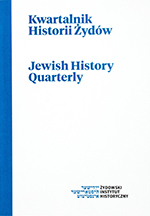„Przy tej pracy żółkły jak kanarki, a ręce ich pokrywały się wrzodami”. O sytuacji żydowskich kobiet w skarżyskiej fabryce amunicji HASAG podczas II wojny światowej
„Their carnation turned so yellow they looked like canaries, and their hands were covered in ulcers.” The Situation of Jewish Women in Hasag Munitions Plant in Skarżysko-Kamienna during World War II.
Author(s): Alicja BartnickaSubject(s): History, Social history, Recent History (1900 till today), History of Judaism, History of Antisemitism
Published by: Żydowski Instytut Historyczny
Keywords: World War II; Hasag; Jewish forced labourers; State Munitions Factory Skarżysko-Kamienna; Hugo Schneider Aktiengesellschaft; Holocaust; Nazi occupation of Poland; Radom district
Summary/Abstract: The State Munitions Factory in Skarżysko-Kamienna, which during World War II was subordinated to the Leipzig-based Hasag corporation once it was seized by the Germans, to produce munitions for the III Reich, was the largest of the 64 companies from the General Government area supplying the German forces. From 1941 the Hasag plant in Skarżysko used the work of Jewish forced labourers, for whom over time the Nazis resolved to set up a labour camp on the factory grounds. According to historians, between 25 and 30 thousand Jews passed through this factory camp, while the number of forced labourers who were murdered could be as high as 18,000 or even 23,000. A large part of them were women, chiefly young women, ferried to Skarżysko from the ghettos in the surrounding area, or from the camps in Majdanek and in Płaszów. This article focuses on the situation of female Jewish forced labourers who were ordered to work in the Skarżysko Hasag plant. The analysis involves issued related to daily life in the camp: from the assignment to work in a specified Werk, which due to the diversified nature of the victims’ obligations became an element of survival already at the start, to issued related to food, lodging or hygiene. I also looked at the complicated relations with the Poles, who as Hasag employees commuting to the factory from the town daily on foot had an opportunity to provide food for the Jewish workers. One topic deserving special attention was sexual violence against the Jewesses committed by German and Ukrainian supervisors in the factory. The reason this is important is that there were many instances of rape of the Jewish women, which contradicts the theories that the German operatives, faithful to the National Socialist ideology did not sexually abuse Jewish women during the war. A separate topic was the question of children, both those taken to the camp along with their mothers and those that were born already in the camp. The article also reviews the Jewish women’s survival strategies, with special emphasis on the „cousin relationship,” quite common at Hasag. The study was made from a feminist perspective, understood as a research approach based on the need to supplement the knowledge of the Holocaust with what the women experienced.
Journal: Kwartalnik Historii Żydów
- Issue Year: 285/2023
- Issue No: 01
- Page Range: 111-137
- Page Count: 27
- Language: Polish
- Content File-PDF

